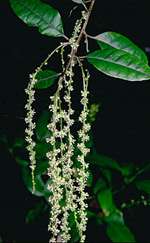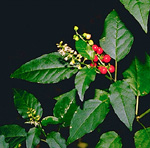 |
This small family is found in tropical and warm areas of the world, especially
in the Americas. It is represented in Australia by two introduced species
and one native one. These occur on disturbed edges of rainforests in Queensland
and New South Wales (Rivina and Monococcus), or more widely
in disturbed places, such as roadsides, in the southern states (Phytolacca).
Characteristic features of the family Phytolaccaceae in Australia include: - soft shrubs or erect, stout, glabrous, somewhat fleshy herbs, often with reddish stems
- leaves alternate, entire, simple
- flowers small, bisexual or unisexual, greenish, in a dense or loose, slender, terminal spike or raceme
- perianth of one whorl of 4 or 5 parts
- stamens 4-20, alternating with sepals; anthers basifixed
- ovary superior, of 1-10 free or loosely fused carpels each with one basal ovule
- fruit a berry with coloured, staining juice or dry and burr-like
Description
Evergreen shrubs, or perennial terrestrial herbs. Perennating by taproots. Internal secretions of coloured sap. Plants glabrous, or with simple, glandular or non-glandular, unicellular hairs. Leaves alternate and spiral, cauline, petiolate. Stipules absent. Lamina simple, symmetric, lanceolate, ovate, elliptic or oblong; base cuneate or attenuate; margins entire, ±flat; venation pinnate, with the midrib conspicuous, and the tertiary venation reticulate; surfaces not punctate; herbaceous. Domatia absent or consisting of hair tufts in the vein angles. Male and female flowers occurring on the same plant or on separate plants, or with all the flowers bisexual. Inflorescences axillary, leaf opposed or terminal, consisting of racemes. Bracts present. Bracteoles present or absent. Flowers stalked. Floral disc present or absent; nectaries present on the disc. Perianth regular, of 1 whorl only, with 4–5 free petaloid segments, imbricate in bud, white, cream, red, pink or green, without contrasting markings, membranous; claws absent; lobes ±entire. Fertile stamens 4 or 6–numerous, alternating, or opposite and/or alternating with and free of the perianth lobes, free of the ovary and style, distinct from each other, all ±equal. Staminodes present or absent. Anthers dorsifixed, not versatile, opening inwards by longitudinal slits, 2-celled. Ovary superior and sessile. Carpels 1 or 5–16, fused; ovary with 1 or 5–16 locules. Style terminal, single and unbranched, or branched above, or branching from the base. Ovules 1 per locule, ±stalked; placentation basal. Fruit a dry indehiscent achene, or a fleshy berry; the perianth on the maturing fruit dry and persistent. Disseminule macro-surface costate with hooked hairs; micro-surface ±smooth, orange, red, brown or black, glossy or dull. Seeds 1–16 per fruit. Aril absent. Cotyledons 2. Embryo curved.
(Note: this description has been generated from the coded data compiled for the key. Any errors in the key data will be reflected in the descriptions.)
A treatment of the family Phytolaccaceae has been published in:
Flora of Australia 4: 1-5.
Australian genera of Phytolaccaceae (as recognised for the Flora of Australia)
* = all species introduced
Monococcus
*Phytolacca
*Rivina

|
  |

Monococcus echinophorus (flowers)
Photo: G.Leiper © G.Leiper

Rivina humilis (flowers and fruits)
Photo: G.Leiper © G.Leiper
|
 |
|